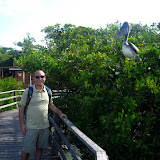I've been here three days now, and easily the most striking thing is the total indifference of the animals to the humans around them. The sea lions, in particular, are happy to put themselves anywhere that there's shade, whether that means on a bench or next to a table at the bar. Some of the smaller finches and lava lizards might freak out and flee when approached, but one can walk right up to a sea lion, pelican, marine iguana, or giant tortoise without scaring it away. Although there is now a decently-sized human population living out here--Puerto Ayora has over 10,000 inhabitants--it still has the feel of a place that evolved over the course of millennia free of human contact. The Galapagos dove, which is basically a pigeon with a piercing blue circle around its eyes, was described by Darwin as being so oblivious that "I could kill by throwing my hat at it."
The animal that has actually captured my attention more than any other so far is the frigatebird. It's rather large, with a wingspan similar to that of a vulture or some other large bird of prey. Among the frigatebird's methods of obtaining food is a technique called kleptoparasitism. In this, the frigatebird will identify another (smaller) bird--let's say a gull--who has just eaten, and harrass said gull until the it vomits. Sometimes this involves catching the gull by the tail and shaking it aggressively in the air. The frigatebird will then eat the regurgitated meal, taking the needed nutrients for itself. Nature, as they say, doesn't fuck around.
The islands have a massive number of species of plants and animals that are endemic, meaning they don't exist anywhere else. One of these is a form of prickly pear cactus that grows as a tree, and mostly appears along the coastline. I'm still trying to figure out how to incorporate such a thing into my conception of reality. I'm not there yet, but I'm getting close.
Another well-known group of endemic species is the finch family. They're generally not that exciting to look at--they're quite small and the coloration isn't particularly thrilling. But, given that they're the very birds that contributed so significantly to the development of Darwin's theory of natural selection, they end up being rather captivating. What's funny, however, is that Darwin came here far more focused on the geology of the place--it's basically a big series of volcanos. In fact, he barely even collected any samples of finches--just two of the thirteen or so species. It was not until he got back to England that he realized what he had seen, and had to borrow samples from Robert FitzRoy, the captain of the HMS Beagle. Accidental though Darwin's realizations may have been, it's fascinating and wonderful to be in the place responsible for them, and to witness firsthand the amazing biodiversity of an ecosystem left to evolve more or less on its own for thousands of years.
This evening I'll be boarding a schooner for a six-day cruise around the islands. I'm expecting to see a lot of amazing things, and hoping to avoid letting the boat treat me like a frigatebird treats a gull. I'll check back in when I'm back on land.
Saludos,
Seth
Fotografía:
 |
| Galapagos - Santa Cruz |












This was great. Love all the animal photos especially. It seems like the principle pastime amongst Galapagos wildlife is napping. This is basically my dream. Good stuff.
ReplyDelete